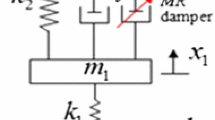Abstract
A semi-active magneto-rheological (MR) damper was experimentally investigated and compared to an original equipment manufacturer (OEM) damper for a passenger vehicle, by using a quarter car models. A full-scale two-degree-of-freedom quarter car experimental set-up was constructed to study the vehicle suspension. On-off skyhook controller and Fuzzy-Lyapunov skyhook controller (FLSC) were employed to control the input current for MR damper so as to achieve the desired damping force. Tests were done to evaluate the ability of MR damper for controlling vehicle vibration. Test results show that the semi-active MR vehicle suspension vibration control system is feasible. In comparison with OEM damper, on-off and FLSC controlled MR dampers can effectively reduce the acceleration of vehicle sprung mass by about 15% and 24%, respectively.
Similar content being viewed by others
References
NAUDE A F, SNYMAN J A. Optimisation of road vehicle passive suspension systems [J]. Applied Mathematical Modelling, 2003, 27: 249–274.
NAGAI M, MORAN A, TAMURA Y, KOIZUMI S. Identification and control of nonlinear active pneumatic suspension for railway vehicles, using neural networks [J]. Control Eng Practice, 1997, 5(8): 1137–1144.
YAGIZ N, HACIOGLU Y. Backstepping control of a vehicle with active suspensions [J]. Control Eng Practic, 2008, 16: 1457–1467.
PRIYANDOKO G, MAILAH M, JAMALUDDIN H. Vehicle active suspension system using skyhook adaptive neuro active force control [J]. Mechanical Systems and Signal Processing, 2009, 23: 855–868.
JONASSON M, ROOS F. Design and evaluation of an active electromechanical wheel suspension system [J]. Mechatronics, 2008, 18: 218–230.
SUNG K G, HAN Young-min, CHO J W, CHOI S B. Vibration control of vehicle ER suspension system using fuzzy moving sliding mode controller [J]. J Sound Vib, 2008, 311: 1004–1019.
RAO M V C, PRAHLAD V. A tunable fuzzy logic controller for vehicle-active suspension systems [J]. Fuzzy Sets and Systems, 1997, 85: 11–21.
SOLOMON U, PADMANABHAM C. Semi-active hydro-gas suspension system for a tracked vehicle [J]. J Terramechanics, 2011, 48: 225–239.
GORDON T. Non-linear optimal control of a semi-active vehicle suspension system [J]. Chaos Solitons & Fractals, 1995, 5(9): 1603–1617.
GUGLIELMINE E, KEVIN A E. A controlled friction damper for vehicle applications [J]. Control Eng Pract, 2004, 12: 431–443.
WANG Hong-jun, TIAN Ai-ling, TANG Qian, CHEN Zhi-li, LIU Bing-cai. Research on rheological property of magnetorheological fluid [C]// 3rd International Symp on Advanced Optical Manufacture and Testing Technology: Advanced Optical Manufacturing Technologies Proc of SPIE. Chengdu, China: 2007, 672230: 1–5.
KUZHIR P, LOPEZ-LOPEZ M T, BOSSIS G. Abrupt contraction flow of magnetorheological fluids [J]. Phys Fluids, 2009, 21(053101): 1–13.
MIAO Chun-lin, KIRK M B, ANNE E M, SHAI N S, JESSICA E D, STEPHEN D J. Magnetorheological fluid template for basic studies of mechanical-chemical effects during polishing [C]// Optical Manufacturing and Testing VII Proc of SPIE. San Diego, California, USA: 2007, 667110: 1–11.
CHO S W, JUNG H J, LEE L W. Smart passive system based on magnetorheological damper [J]. Smart Materials and Structures, 2005, 15(4): 707–714.
YAO G Z, YAP F F, CHEN G, LI W H, YEO S H. MR damper and its application for semi-active control of vehicle suspension system [J]. Mechatronics, 2002, 12: 963–973.
GEORGIOS T, CHARLES W S, EMANUELE E. Hybrid balance control of a magnetorheological truck suspension [J]. J Sound Vib, 2008, 317: 514–536.
YU Miao, DONG Xin-min, CHOI S B, LIAO Chang-rong. Human simulated intelligent control of vehicle suspension system with MR dampers [J]. J Sound Vib, 2009, 319: 753–767.
POTTER J N, NEILD S A, WAGG D J. Quasi-active suspension design using magnetorheological dampers [J]. J Sound Vib, 2011, 330: 2201–2219.
Author information
Authors and Affiliations
Corresponding author
Additional information
Foundation item: Project(51175265) supported by the National Natural Science Foundation of China; Project(CX10B_114Z) supported by Jiangsu College Graduate Research and Innovation Program, China; Project(BK2008415) supported by the Natural Science Foundation of Jiangsu Province, China; Project(Y1110313) supported by the Natural Science Foundation of Zhejiang Province, China
Rights and permissions
About this article
Cite this article
Jiang, Xz., Wang, J. & Hu, Hs. Semi-active control of a vehicle suspension using magneto-rheological damper. J. Cent. South Univ. 19, 1839–1845 (2012). https://doi.org/10.1007/s11771-012-1217-9
Received:
Accepted:
Published:
Issue Date:
DOI: https://doi.org/10.1007/s11771-012-1217-9




